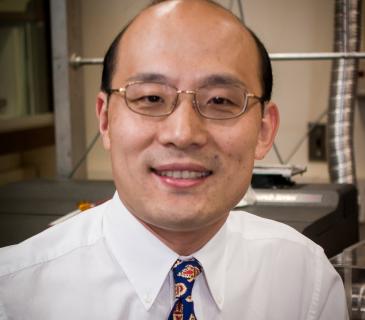Liang T. Chu, PhD

The current research focus in Dr. Chu's laboratory involves the studies of the heterogeneous atmospheric reactions on ice-cloud and particle surfaces and photochemistry of ice. These reactions occur in both the troposphere and lower stratosphere and can be very important to understand ozone depletion, climate change and radiative transfer.
The key chemical process of polar ozone depletion is the heterogeneous chlorine and bromine activation on Polar Stratospheric Cloud (PSC) surfaces. We have demonstrated that the uptake of HBr on ice films, which are used to mimic type II PSCs, is about 1013 molecules/cm3 at PHBr~10-8 Torr and 188 K. This implies that HBr surface coverage is sub-monolayer on a PSC surface. Hydrobromic acid hydrates (both tri- and dihydrates) were formed at higher PHBr and identified in the laboratory. The study implies that the heterogeneous bromine reactions are an important factor contributing to ozone depletion. The process is even more significant when the chlorine and bromine species are coupled together.
The study was carried out in a fast-flow reactor and the HBr molecule was detected by a differentially pumped mass spectrometer in the ultra-high vacuum condition. This ultra-sensitive instrument also allows us to study numerous chemical reactions. For example, we have investigated the reaction mechanism of HOCl+HBr(ad)→BrCl+H2O(ad). This reaction activates both the photochemical inactive chlorine and bromine on the ice-cloud surface, simultaneously. The study provides us not only the reaction probability, γ, but also the reaction mechanism in which we can show how HOCl and HBr molecules come together near the ice surface and to produce BrCl.
Some current research projects include photochemistry of ice, determination of near UV extinction of ice and refractive index using cavity ring-down spectroscopy.
A combination of FT-IR absorption and temperature programmed desorption (TPD) technique is used to determine molecular structures of both gas-phase and adsorbed species in Dr. Chu's laboratory. We employ the specular reflective FT-IR absorption technique to probe the adsorption of oxalic acid on ice surfaces, and desorbed species are probed by mass spectrometer in a TPD experiment.
Combined with theoretical chemistry calculations such as molecular dynamics simulations, the detailed knowledge as to how and where oxalic acid is adsorbed on the ice and possibly the hydration mechanism can be revealed. We will be able to shed light on the chemical binding nature of some atmospherically important species on ice-cloud surfaces and understand the halogen activation on molecular crystal ice surfaces at a molecular level. This will provide a better understanding of ozone loss mechanism in the atmosphere.
